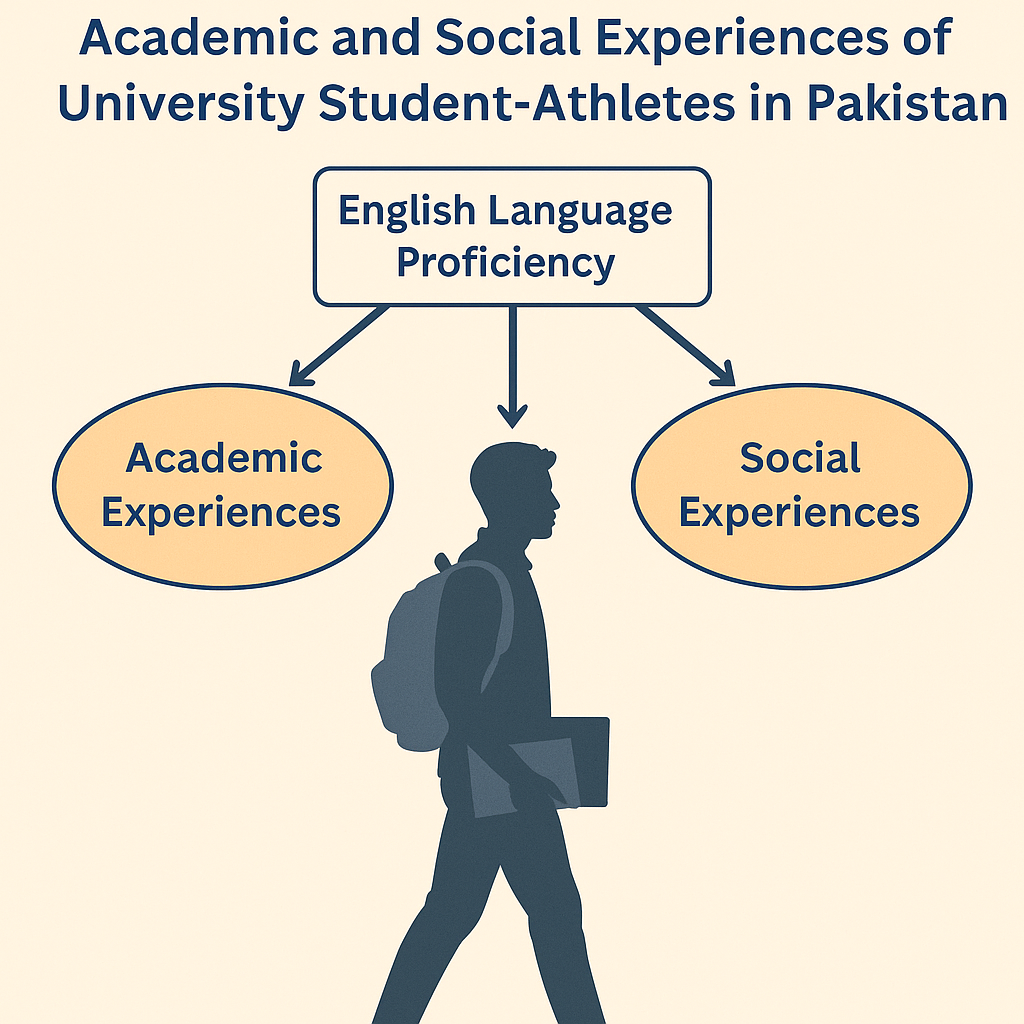Influence of English Language Proficiency on Academic and Social Experiences of University Student-Athletes in Pakistan
##semicolon##
English language proficiency##common.commaListSeparator## student-athletes##common.commaListSeparator## academic achievement##common.commaListSeparator## social integration##common.commaListSeparator## university education##article.abstract##
Social integration of university student-athletes in Pakistan. University life in Pakistan presents unique challenges for student-athletes, especially those with limited command of English, which can affect their academic performance, classroom participation, and ability to build effective relationships with peers and instructors. To explore these dynamics, a mixed-methods approach was employed involving 200 student-athletes from two universities in Faisalabad. Quantitative data were gathered through structured surveys measuring students’ English language competency, academic outcomes, and social engagement, while qualitative data were collected through semi-structured interviews. Thematic analysis was used to examine qualitative responses, and appropriate statistical methods were applied to analyze quantitative findings. Results indicated that student-athletes with higher English proficiency performed better academically, participated more confidently in class, and integrated more easily into social circles. In contrast, those with limited proficiency often experienced academic stress, social isolation, and difficulty in meeting academic standards. These findings highlight the compounded burden faced by student-athletes in managing both academic and athletic responsibilities. Limited English proficiency was shown to intensify this burden, potentially impacting their overall university experience and future career opportunities. The study underscores the need for universities to implement targeted language support programs that can help student-athletes overcome linguistic challenges, thereby promoting a more inclusive and equitable academic environment. The research concludes that strengthening English language skills is essential for the academic and social success of student-athletes in higher education institutions in Pakistan.
##plugins.themes.default.displayStats.downloads##
##submission.citations##
References
1. Accardo, A. L., Ferguson, S. L., Alharbi, H. M., Kalliny, M. K., Woodfield, C. L., & Vernon-Dotson, L. J. (2023). Unified Sports, social inclusion, and athlete-reported experiences: A systematic mixed studies review. Inclusion, 11(1), 23-39.
2. Afriani, R., & Sepdanius, E. (2025). The influence of English in sports activities on vocabulary understanding and communication behavior in sports context: PLS-SEM analysis. Retos: Nuevas Tendencias En Educación Física, Deporte Y Recreación, 65, 532-544.
3. Ahmed, A. S., Sadeea, H., & ul Hassan, S. M. (2020). The relationship of sports and physical activity to the academic achievement-a case of hearing-impaired children. The Sky-International Journal of Physical Education and Sports Sciences, (1), 170-182.
4. Ahmed, S., Khan, D. S., Khan, D. W., & Asif, A. (2024). Understanding English language speaking anxiety among pakistani university students: A teacher centric exploration. Sindh Journal of Linguistics, 3(1), 20-36.
5. Anderson, J. A., Mak, L., Keyvani Chahi, A., & Bialystok, E. (2018). The language and social background questionnaire: Assessing degree of bilingualism in a diverse population. Behavior Research Methods, 50, 250-263.
6. Chan, C. C. (2020). Social support, career beliefs, and career self-efficacy in the determination of Taiwanese college athletes’ career development. Journal of Hospitality, Leisure, Sport & Tourism Education, 26, 100232.
7. Escoto, D. G., & Alfarero, J. A. (2022). Winning it both: Stories of secondary academic achiever student-athletes. European Journal of Physical Education and Sport Science, 9(2).
8. Huang, S. H., & Tsai, K. L. (2024). Language learning strategies in focus: Exploring their utilization by college student-athletes. Language Learning in Higher Education, 14(1), 229-251.
9. Hyland, K. (2019). Second language writing. Cambridge University Press.
10. Javed, A. (2020). Predicting the underlying factors of academic dishonesty by university students: A case study.
11. Javed, F. (2020). Adaptation challenges faced by Pakistani university entrants. Student Success, 11(2), 41-51.
12. Khan, K., Qadir, A., Trakman, G., Aziz, T., Khattak, M. I., Nabi, G., ... & Shahzad, M. (2022). Sports and energy drink consumption, oral health problems and performance impact among elite athletes. Nutrients, 14(23), 5089.
13. Krämer, D. (2024). Artificial Intelligence in Sports: Insights from a Quantitative Survey among Sports Students in Germany about their Perceptions, Expectations, and Concerns regarding the Use of AI Tools.
14. Kuwahara, D. S. (2018). The Impact of academic support services on division i student-athletes’ college degree completion (Doctoral dissertation, University of Southern California).
15. Munawar, U., Haider, S. Z., Nazeer, H., & Hussain, M. (2023). Sustainability of higher education through distance and online learning during global educational lockdown in Pakistan: A case study of Women University Multan. Pakistan Journal of Humanities and Social Sciences, 11(2), 2744-2750.
16. Rafiq, S., Afzal, A., & Kamran, F. (2022). Impact of school environment on students’ academic achievements at the university level. VFAST Transactions on Education and Social Sciences, 10(4), 19-30.
17. Carroll, B., & Hollinshead, G. (2017). Equal opportunities: Race and gender in physical education: A case study. In Equality, Education, and Physical Education (pp. 154-169). Routledge.
18. Siddiky, M. R. (2019). Developing co-curricular activities and extra-curricular activities for all-round development of the undergraduate students: A study of a selected public university in Bangladesh. Pakistan Journal of Applied Social Sciences, 10(1), 61-82.
19. Steele, P., Burleigh, C., Bailey, L., & Kroposki, M. (2020). Studio thinking framework in higher education: Exploring options for shaping immersive experiences across virtual reality/augmented reality curricula. Journal of Educational Technology Systems, 48(3), 416-439.
20. Zafar, S., Altaf, F., & Saeed, M. (2020). A Study to Explore Minimum Level of English Proficiency for ESL Teachers at Middle School. Journal of Secondary Education and Research, 2(2), 1-18.

##submission.downloads##
##submissions.published##
##issue.issue##
##section.section##
##submission.license##
##submission.copyrightStatement##
##submission.license.cc.by-nc-nd4.footer##



